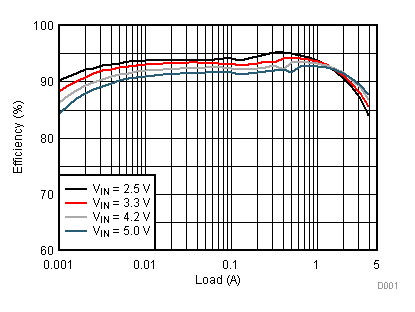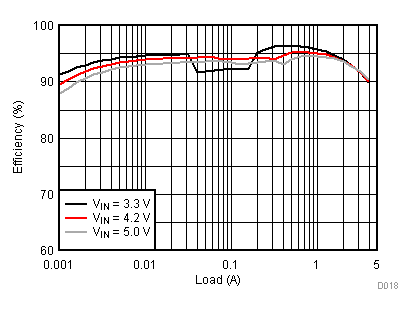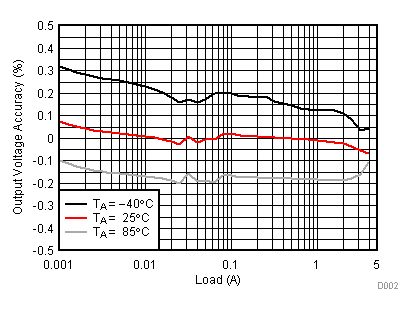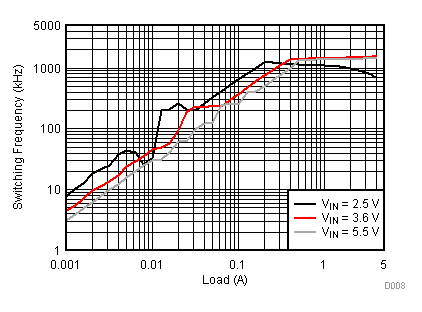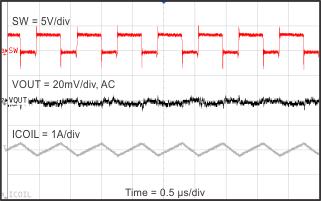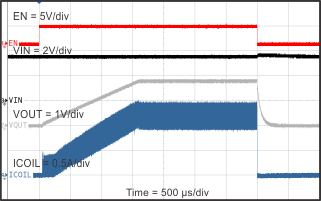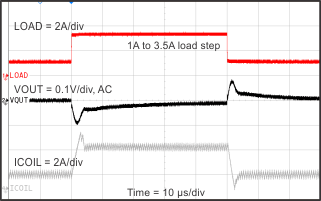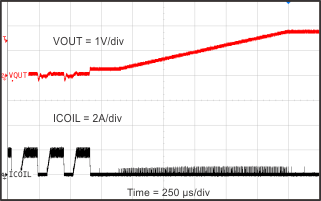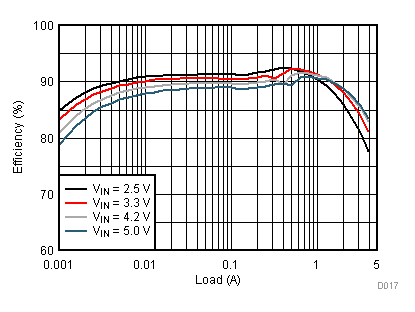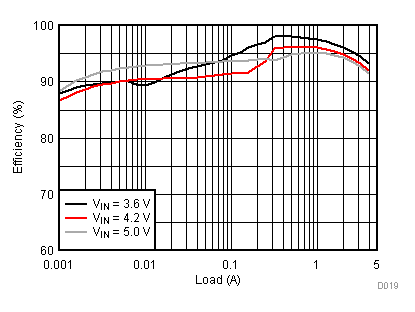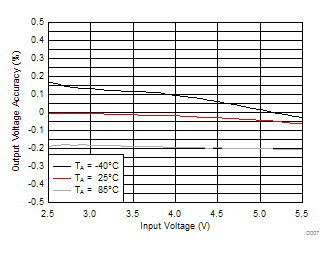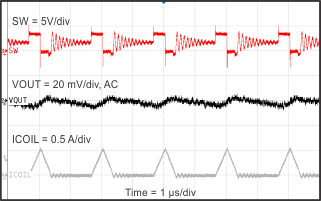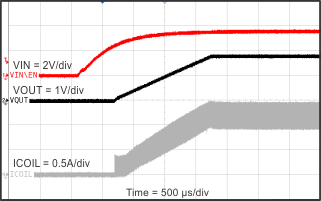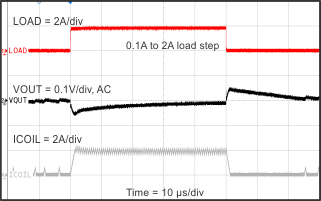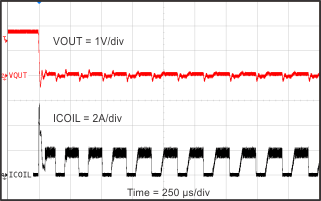ZHCSF07A March 2016 – January 2017 TLV62095
PRODUCTION DATA.
- 1 特性
- 2 应用范围
- 3 说明
- 4 修订历史记录
- 5 Pin Configuration and Functions
- 6 Specifications
- 7 Detailed Description
- 8 Application and Implementation
- 9 Power Supply Recommendations
- 10Layout
- 11器件和文档支持
- 12机械、封装和可订购信息
8 Application and Implementation
NOTE
Information in the following applications sections is not part of the TI component specification, and TI does not warrant its accuracy or completeness. TI’s customers are responsible for determining suitability of components for their purposes. Customers should validate and test their design implementation to confirm system functionality.
8.1 Application Information
The TLV62095 is a 4-A high frequency synchronous step-down converter optimized for small solution size, high efficiency and suitable for battery powered applications.
8.2 Typical Applications
8.2.1 1.8-V Output Converter
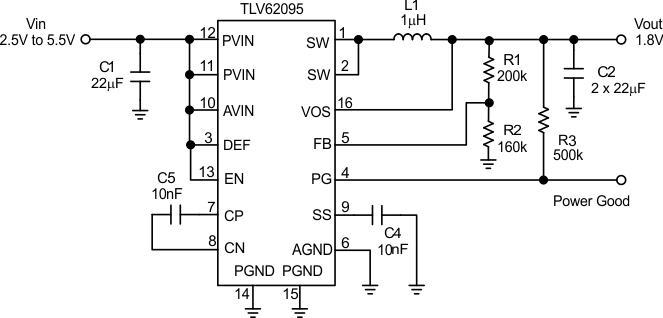 Figure 7. TLV62095 Typical Application Circuit
Figure 7. TLV62095 Typical Application Circuit
8.2.1.1 Design Requirements
The design guideline provides a component selection to operate the device within the recommended operating conditions. For the typical application example, the following input parameters are used.
Table 2. Design Parameters
| DESIGN PARAMETER | EXAMPLE VALUE |
|---|---|
| Input voltage range | 2.5 V to 5.5 V |
| Output voltage | 1.8 V |
| Output ripple voltage | < 30 mV |
| Output current rating | 4 A |
Table 3 shows the list of components for the Application Characteristic Curves.
Table 3. List of Components
| REFERENCE | DESCRIPTION | MANUFACTURER |
|---|---|---|
| TLV62095 | High efficiency step-down converter | Texas Instruments |
| L1 | Inductor: 1 µH | Coilcraft XAL4020-102 |
| C1, C2 | Ceramic capacitor: 22 μF | (6.3V, X5R, 0805) |
| C4, C5 | Ceramic capacitor, 10 nF | Standard |
| R1, R2, R3 | Resistor | Standard |
8.2.1.2 Detailed Design Procedure
8.2.1.2.1 Custom Design With WEBENCH® Tools
Click here to create a custom design using the TLV62095 device with the WEBENCH® Power Designer.
- Start by entering the input voltage (VIN), output voltage (VOUT), and output current (IOUT) requirements.
- Optimize the design for key parameters such as efficiency, footprint, and cost using the optimizer dial.
- Compare the generated design with other possible solutions from Texas Instruments.
The WEBENCH Power Designer provides a customized schematic along with a list of materials with real-time pricing and component availability.
In most cases, these actions are available:
- Run electrical simulations to see important waveforms and circuit performance
- Run thermal simulations to understand board thermal performance
- Export customized schematic and layout into popular CAD formats
- Print PDF reports for the design, and share the design with colleagues
Get more information about WEBENCH tools at www.ti.com/WEBENCH.
8.2.1.2.2 Output Filter
The first step is the selection of the output filter components. To simplify this process, Table 4 outlines possible inductor and capacitor value combinations.
Table 4. Output Filter Selection
| INDUCTOR VALUE [µH](3) | OUTPUT CAPACITOR VALUE [µF](2) | ||||
|---|---|---|---|---|---|
| 10 | 22 | 2 x 22 | 100 | 150 | |
| 0.47 | |||||
| 1.0 | √(1) | √ | √ | ||
| 2.2 | |||||
8.2.1.2.3 Inductor Selection
The inductor selection is affected by several parameters like inductor ripple current, output voltage ripple, transition point into Power Save Mode, and efficiency. See Table 5 for typical inductors.
Table 5. Inductor Selection
| INDUCTOR VALUE | COMPONENT SUPPLIER(1) | SIZE (LxWxH mm) | Isat / DCR |
|---|---|---|---|
| 1 µH | Coilcraft XAL4020-102 | 4.0 x 4.0 x 2.1 | 8.75A / 13.2 mΩ |
| 0.47 µH | TOKO DFE322512C | 3.2 x 2.5 x 1.2 | 5.9A / 21 mΩ |
In addition, the inductor has to be rated for the appropriate saturation current and DC resistance (DCR). The inductor needs to be rated for a saturation current as high as the typical switch current limit of 5.5A or according to Equation 5 and Equation 6. Equation 5 and Equation 6 calculate the maximum inductor current under static load conditions. The formula takes the converter efficiency into account. The converter efficiency can be taken from the data sheet graphs or 80% can be used as a conservative approach. The calculation must be done for the maximum input voltage where the peak switch current is highest.


where
ƒ = Converter switching frequency (typically 1.4MHz)
L = Inductor value
η = Estimated converter efficiency (use the number from the efficiency curves or 0.80 as a conservative assumption)
Calculating the maximum inductor current using the actual operating conditions gives the minimum saturation current. A margin of 20% should be added to cover for load transients during operation.
8.2.1.2.4 Input and Output Capacitor Selection
For best output and input voltage filtering, low ESR (X5R or X7R) ceramic capacitors are recommended. The input capacitor minimizes input voltage ripple, suppresses input voltage spikes and provides a stable system rail for the device. A 22-μF or larger input capacitor is recommended. The output capacitor value can range from 10 μF up to 150 μF and beyond. Load transient testing and measuring the bode plot are good ways to verify stability with larger capacitor values.
The recommended typical output capacitor value is 2 x 22 μF (nominal) and can vary over a wide range as outline in the output filter selection table. Ceramic capacitor have a DC-Bias effect, which has a strong influence on the final effective capacitance. Choose the right capacitor carefully in combination with considering its package size and voltage rating.
8.2.1.2.5 Setting the Output Voltage
The output voltage is set by an external resistor divider according to the following equations:



When sizing R2, in order to achieve low quiescent current and acceptable noise sensitivity, use a minimum of 5 µA for the feedback current IFB. Larger currents through R2 improve noise sensitivity and output voltage accuracy.
8.2.1.3 Application Performance Curves
TA = 25°C, VIN = 3.6 V, VOUT = 1.8 V, unless otherwise noted.
